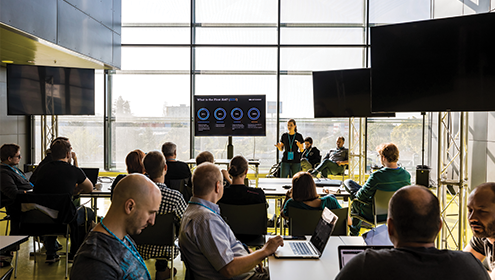
Navigating the Tech Landscape: Career Paths for Software Engineers at NETCONOMY

Our company and our technology stack have grown rapidly over the years. Our people grew with them and, naturally, wanted to increase their impact, develop in certain directions, or become specialists in specific areas.
Our goal is to offer everyone at NETCONOMY the opportunity to take control of their career growth supported by their lead and a clear, concise framework.
In this article, we’ll describe our software development career path, explain how we set it up, and share what we learned along the way.
How Our Software Engineer Career Paths Look Like
The career path of our software engineers has come a long way. Four years ago, a working group of employees from various technical departments met for the first time and brainstormed ideas for a career path.
The first idea that was piloted was for a single level, called “Software Engineer”. The idea behind this was that people in this position could choose which skills or abilities they want to acquire – like in an AppStore, where you simply “download” what you want and thus build up your cell phone. However, it would have been challenging to implement this model since jobseekers are used to being categorized into junior and senior positions. This lack of categorization also poses a problem when applying for jobs at other companies, as the recruiters can’t correctly classify the skills or experience of people.
That’s why we stepped back from that idea, and our working groups reassembled. During the second round, we developed the basic frame of our current model and have continued refining it.
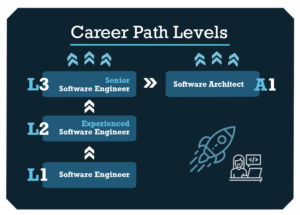
Back then, we still had two big containers of hard and soft skills that helped define an employee’s level. To determine the exact level, people rated their abilities on a scale of 1 to 10 for each listed skill. We saw that with this approach, juniors mostly rated their skills as a three, and seniors gave a higher score the longer they had been in the company. While this reflected the length of time people were in a position, it still did not show how proficient someone was in a specific skill. We knew we had to change something but not exactly what. So, we sent some of our colleagues in the trial run to conferences and training courses on career growth.
There we learned that there are better approaches than a simple division of skills, and that we need to differentiate between behaviors and competencies. Based on this principle, we adapted the old model and configured it to the one we currently use.
Our Approach: Behaviors vs. Competencies
What does it mean to separate behavior from competencies? Let’s look at this with an example: a technical employee champions user stories on an ongoing basis. The behavior they show over time is the execution of the task to champion user stories. This is deepened over several repetitions and can be continuously improved by performance management and guidance from the respective lead. However, the competencies they must have are presentation and communication skills. These can be improved through training sessions or workshops. Therefore, we defined competencies for each level in our career paths that can be acquired or enhanced in trainings that we suggest for each level.
Of course, our people are supported and guided individually by our internal training academy and can suggest other trainings, that they think will be a fit for them.
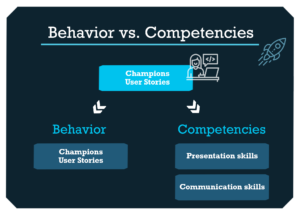
Put simply, this means we expect a defined set of behaviors and competencies for each level. We have developed a separate questionnaire for each level to make it easier for employees and the lead to assess and rank their skills in both areas, instead of letting them rank themselves from 1 to 10 as we did before. With our newly defined process, they go through this assessment several times a year instead of yearly employee appraisals.
Our Career Growth Process
The newly devised process consists of four parts:
- The first part consists of feedback meetings held throughout the year. These meetings can cover a 360-degree view of the employee’s performance or focus on specific aspects in detail with the aim of providing constructive feedback. The new approach aims to accurately address the expectations in each role and highlight to what extent they are being met.
- In calibration meetings, leads and department leads discuss and evaluate the performance of a specific employee. This creates more fairness, as the evaluation is no longer carried out by just one person and the promotion to the next level must be discussed.
- In the assessment phase, leads discuss the calibration meetings’ feedback with their employees. Before the new framework, we mainly set annual targets in this phase. Now, areas for improvement are shown through customized feedback sheets that were tested and reworked throughout the test phase. As a result, the lead and employee come up with a development plan for the next level and enrich it with suitable trainings or workshops.
- The final part is the promotion Here, the changes regarding responsibilities and expectations are discussed again in detail, and any questions, suggestions, or requests from the employee are explored.
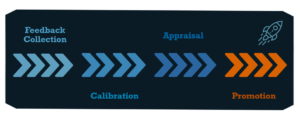
Jürgen started with us as a testing agent during his studies and has had an impressive career since then. After completing our internal traineeship, he became a software engineer and worked on a project for one of our biggest customers, where he learned how to work in a Scrum team and implement user stories. He completed trainings such as the SAP Commerce Certification and learned new skills, like conceptualizing technical implementation of features or operating Kubernetes. As he went through the different levels, he got used to collaborating closely with customers and working on a project from start to finish with tight deadlines. He earned certifications such as the iSAQB Certified Professional for Software Architects and the Google Cloud Professional Architect. He is now in Level A1, working on complex migration scenarios as a software architect.
However, he is still busy completing trainings and gaining new experiences, such as working in a SAFe environment. Here’s what he has to say firsthand about our career path:
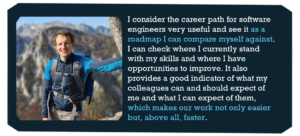
The Perspectives
What are the possibilities once you reach the senior level and don’t want to become Software Architect? Of course, your career path is not over. The trident model allows our colleagues in senior positions to develop in three different directions:
- management positions
- technical leadership
- individual contributor who is a specialist in an area of their interest
For this purpose, the respective leads develop an individual development path with their employees, paying attention to specific wishes, interests, and circumstances.
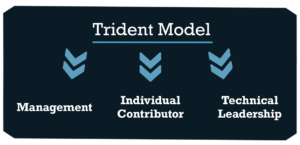
Why We Developed This Career Path?
Our mindset is growth-oriented, and that is reflected in our people. They want to constantly develop, acquire new skills, and keep up with the changing demands of the market. At NETCONOMY, we give them the freedom and support to grow, but we didn’t have a clear career path and defined perspective for our technical staff to hold on to and strategically plan their growth within the company.
Since we didn’t clearly define what is expected from developer positions, we also couldn’t determine a set of skills they required. This meant that we couldn’t efficiently set up training paths, which resulted in a lack of orientation for our technical staff. By developing a framework, we clearly defined role descriptions and processes for career development, set expectations for all levels, and established ongoing improvement and learning plans.
Max is one of our software development leads and has been closely involved in the setup from the very beginning. He told us that unclear career prospects were a major problem for our software engineers, and therefore we decided to introduce career paths.
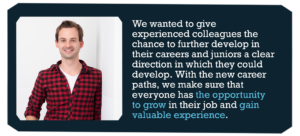
Moreover, Max said, we can provide more transparency and fairness in individual career development. Performance evaluation is based on standardized and transparent evaluation criteria. In addition, training and learning needs are now documented, which allows us to identify gaps and better meet the needs of devs. Furthermore, the defined expectations towards our software engineers help our organization to plan and staff projects properly – based on the strengths and interests of our engineers.
Of course, we believe that all our employees should have a clearly defined perspective for their future career path. Therefore, our other departments are also in the process of working out suitable career paths for them. This means there are or will be career paths for non-technical roles. If there is no fixed framework yet, we are always open to exploring with our employees a path to their desired future and working together on a plan to get there.
If you want to know more or are already prepared to plan your future career path with us, contact us.

